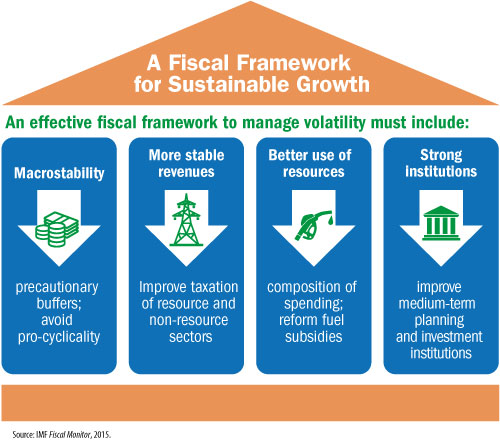
Typical street scene in Santa Ana, El Salvador. (Photo: iStock)
IMF Survey : How Fiscal Policy Can Tame the Commodities Roller Coaster
October 7, 2015
- Countries that build buffers have a softer landing when commodity prices and revenues go down
- Public investment and social spending must be carefully managed to deliver long-lasting benefits
- Strong fiscal frameworks and institutions can ensure natural resources support long-term growth
Resource-rich economies face enormous challenges to manage volatile and unpredictable commodity prices. In its latest Fiscal Monitor, the IMF examines how countries can tax and spend wisely so that their oil, gas and metals support strong and stable economic development.

Constructing strong fiscal frameworks can tame the roller coaster of volatile natural resource revenues (Photo: C.J. Burton/Corbis).
Fiscal Monitor
Fiscal policy can either calm or magnify the effects of volatile commodity prices on the domestic economy. In many countries, large swings in commodity prices have resulted in large fluctuations in public expenditures and, in turn, exacerbated economic volatility.
The right reforms can make a difference. “Improved fiscal frameworks and policies can help ensure that natural resources are truly a blessing for resource-rich countries,” said Vítor Gaspar, Director of the IMF’s Fiscal Affairs Department.
So how can countries tame the commodities roller coaster? The report outlines how more stable expenditures can give a smoother ride, how well-planned public investment can help a steady economic climb, and how fiscal frameworks can lay the track for the long-term future.
A smoother ride: preserving economic stability
The experience of recent decades shows that many countries find it difficult to manage volatility around commodities. Their public expenditure tends to significantly accelerate during price upswings and fall during downswings. This is how fiscal policy can play a major role in transmitting commodity price volatility to the domestic economy. Macroeconomic instability, in turn, hampers sustainable growth.
The latest commodity price cycle illustrates the point. Many countries saw a massive increase in budget revenues during the 2003-08 revenue windfall, exceeding 200 percent of 2002 GDP in some cases, which financed enormous increases to expenditures. There are cases in which the size of the budget more than tripled. In contrast, other countries did build large fiscal buffers during the years of high commodity prices.
With the latest sharp fall in commodity prices, most countries will have to cut expenditures, in some cases by large amounts. However, those with fiscal buffers will be able to apply the brakes at a more gradual pace and cushion the impact on the economy.
A steady climb: promoting economic development
Designing an appropriate long-term strategy to manage natural resources is a complex task. If the wealth is simply consumed, the country will become poorer as the natural resources are depleted. Well-designed strategies promote economic development by investing, for example, in infrastructure. Investment in people is as important, namely by achieving strong health and education outcomes. These decisions are complicated due to the need to manage the high uncertainty of resource prices and commodities reserves.
Indeed, many resource-rich countries used a significant share of the recent windfall to boost capital spending, as well as expenditures on health and education. For example, public investment grew by more than 15 percent a year (at constant prices) in 2000-08.
Good policies are needed to ensuring that large increases in public investment and social spending deliver strong growth dividends. Namely, scaling up of public investment needs to be done at a pace that allows space for private investment and takes into account supply bottlenecks. Countries should build financial buffers to avoid costly “stop-go” cycles. Furthermore the pace of public investment should be consistent with the country’s institutional capacity, to ensure projects are wisely selected and efficiently implemented. The same holds for health and education. It is of paramount importance that social spending is effective and efficient.
Laying the tracks: fiscal frameworks
The Fiscal Monitor stresses the importance of developing a comprehensive fiscal framework to better manage public finances amid high uncertainty. It outlines four key main areas:
• First, set an appropriate long-term fiscal target to guide fiscal policy. This is especially important given that oil, gas and metals are non-renewable. It also calls for long-term stabilization savings to weather the large and persistent shocks.
• Second, intensify efforts to widen the revenue base and avoid an overdependence of government revenue on the resource sector.
• Third, make public spending more efficient. Resource-rich countries are likely to face long periods of lower fiscal revenues. Better management of public investment and expenditure can help ensure that government spending plans are efficient and are likely to yield important growth dividends. There is also room to further reduce energy subsidies.
• Finally, the Fiscal Monitor highlights the importance of developing strong institutions. Experience suggests that improvements, for example to governance and quality government services, are essential to use natural resources in a way that will support long-term growth.








